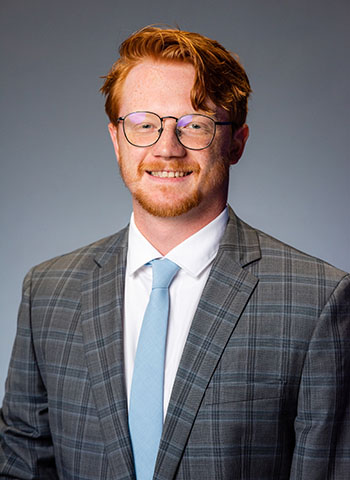Alumnus’ research in 'Science' highlights new plastic material
 As humans work toward a more sustainable future on Earth, imagine having one material that can act like many of the plastics used in daily life. Now consider those same principles being used in outer space, where resources and capacity are precious commodities.
As humans work toward a more sustainable future on Earth, imagine having one material that can act like many of the plastics used in daily life. Now consider those same principles being used in outer space, where resources and capacity are precious commodities.
University of É«×ۺϾþà Mercy alumnus Nicholas Boynton ’19 has pondered these “grand challenges” the past three and a half years. Thanks to his research, these concepts may one day become a reality.
Boynton and a team of nine researchers have created a new plastic material that can change its shape and properties through tempering, the rapid heating and cooling of a substance. , one of the world’s top academic journals, on Feb. 1.
“This is really exciting because generally, when you make a new material, you’re designing the material for one specific thing,” said Boynton. “What we wanted to do was design a material that you could take to, say the Moon or Mars, and instead of having to bring 20 different types of materials for all the different things that you would need, you can just bring one and turn it back and forth into whatever you need. And once you’re done with that application, you can just reprocess and do it again. This is, quite literally, as easy as putting it in an oven at a set temperature.”
Boynton and the other researchers took thermosets, a type of polymer, and added dynamic bonds, which can break and reform at room temperature. They found that they could control how much of the material is bound when the material is heated at high temperatures, and when cooled, the material would retain the number of bonds that were fixed.
Stem cells were the inspiration for this new plastic material, according to Boynton, who is studying for his Ph.D. in molecular engineering at the University of Chicago.
He and the other researchers wanted to make a pluripotent — meaning able to change cell types — synthetic material that, like stem cells, could be used in a variety of ways. They found that the pluripotent plastic could be reprocessed as needed and hold its shape for more than a month.
“We think that this is maybe the start of thinking about materials with these pluripotent properties, where you can get this huge range of properties out of it,” Boynton said.
Boynton’s journey into space science started on É«×ۺϾþà Mercy’s McNichols Campus.
He joined Chair and Professor of Chemistry and Biochemistry Matthew Mio’s research lab as a freshman and spent the next two years working with polyimide aerogels as an intern at NASA. After balancing academics and athletics — he played four years with the Titans’ men’s lacrosse program — Boynton graduated from UDM in 2019 with a Bachelor of Science in Chemistry.
His relationship with NASA has continued into graduate school — Boynton’s Ph.D. is funded through its Space Technology Graduate Research Opportunities program.
 Boynton never imagined that the past several years would unfold this way, culminating with being first author of a paper in Science. This research also caught the eye of the New York Times, which wrote about it in a Feb. 1 article called "A shape-shifting plastic with a flexible future."
Boynton never imagined that the past several years would unfold this way, culminating with being first author of a paper in Science. This research also caught the eye of the New York Times, which wrote about it in a Feb. 1 article called "A shape-shifting plastic with a flexible future."
“I still remember the day I got the email for the first internship at NASA, when I was at UDM,” he said. “I think that was a really exciting day, and I think even in that moment, it was clear that things were probably going to be different moving forward. It was clear that all the work I put in with Professor Mio in the Chemistry lab and starting that research journey kind of paid off there. And then trying to move myself at NASA.
“I think it’s really cool. I don’t know if I would’ve necessarily predicted it.”
After closely watching Boynton develop into a chemist at UDM, Mio is proud of his mentee’s latest accomplishment.
“From the first time I met Nick at É«×ۺϾþà Mercy, he showed a passion for learning about and developing new materials chemistry,” Mio said. “His publication achievement would be the pinnacle of any modern scientist's career, so to have it happen even before he has finished his graduate work speaks of Nick's leadership potential in the field. I am so happy for Nick to have realized his dream and look forward to his future contributions.”
As humans try to implement sustainable and environmentally friendly practices into their lives, Boynton wonders how they could also be applied in space.
“There’s this huge push towards sustainability now, and for very good reasons of trying to understand how to make plastics that are recyclable. I think there’s this other side of sustainability of how can we move and have humans live beyond Earth,” Boynton said. “And to do that, you have to have materials that do things that you’re not used to.”
Boynton acknowledges that this is the first generation of these pluripotent plastics and there is more work to be done. But he hopes his paper in Science inspires others to think differently about the way they make materials.
“I think a lot of people are super focused on making materials for one specific thing, when I think there’s a lot of potential materials that can do a ton of different things, beyond just like multifunctional,” he said. “We’ve seen some really exciting work that others are doing, and we hope that this turns the gears a little bit and gets people thinking in that direction.
“For us, we want to keep going. Because, really, it’s how do you make a material that can be on the Moon or Mars. I think these ones would leave a little bit to be desired in those environments, but perhaps we can really use all the insights to really move in that direction. I think we’re really starting to do that. That would be the ultimate goal, to eventually have something that can be on a spaceship with humans to the Moon or Mars.”
— By Ricky Lindsay. Follow É«×ۺϾþà Mercy on , , and . Have a story idea? Let us know by submitting your idea.
